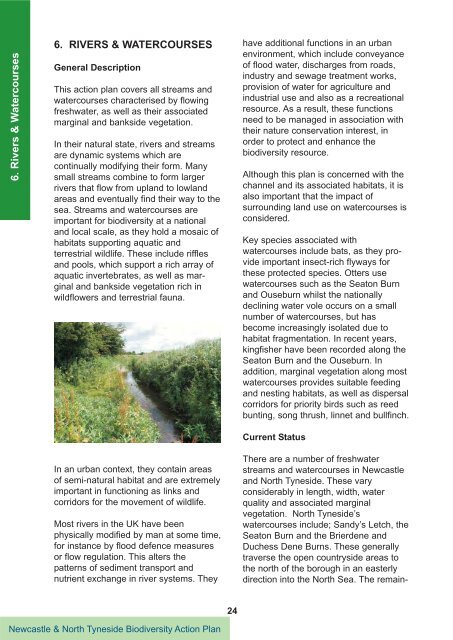III. Species Action Plans - Newcastle City Council
III. Species Action Plans - Newcastle City Council
III. Species Action Plans - Newcastle City Council
Create successful ePaper yourself
Turn your PDF publications into a flip-book with our unique Google optimized e-Paper software.
6. Rivers & Watercourses<br />
6. RIVERS & WATERCOURSES<br />
General Description<br />
This action plan covers all streams and<br />
watercourses characterised by flowing<br />
freshwater, as well as their associated<br />
marginal and bankside vegetation.<br />
In their natural state, rivers and streams<br />
are dynamic systems which are<br />
continually modifying their form. Many<br />
small streams combine to form larger<br />
rivers that flow from upland to lowland<br />
areas and eventually find their way to the<br />
sea. Streams and watercourses are<br />
important for biodiversity at a national<br />
and local scale, as they hold a mosaic of<br />
habitats supporting aquatic and<br />
terrestrial wildlife. These include riffles<br />
and pools, which support a rich array of<br />
aquatic invertebrates, as well as marginal<br />
and bankside vegetation rich in<br />
wildflowers and terrestrial fauna.<br />
In an urban context, they contain areas<br />
of semi-natural habitat and are extremely<br />
important in functioning as links and<br />
corridors for the movement of wildlife.<br />
Most rivers in the UK have been<br />
physically modified by man at some time,<br />
for instance by flood defence measures<br />
or flow regulation. This alters the<br />
patterns of sediment transport and<br />
nutrient exchange in river systems. They<br />
<strong>Newcastle</strong> & North Tyneside Biodiversity <strong>Action</strong> Plan<br />
24<br />
have additional functions in an urban<br />
environment, which include conveyance<br />
of flood water, discharges from roads,<br />
industry and sewage treatment works,<br />
provision of water for agriculture and<br />
industrial use and also as a recreational<br />
resource. As a result, these functions<br />
need to be managed in association with<br />
their nature conservation interest, in<br />
order to protect and enhance the<br />
biodiversity resource.<br />
Although this plan is concerned with the<br />
channel and its associated habitats, it is<br />
also important that the impact of<br />
surrounding land use on watercourses is<br />
considered.<br />
Key species associated with<br />
watercourses include bats, as they provide<br />
important insect-rich flyways for<br />
these protected species. Otters use<br />
watercourses such as the Seaton Burn<br />
and Ouseburn whilst the nationally<br />
declining water vole occurs on a small<br />
number of watercourses, but has<br />
become increasingly isolated due to<br />
habitat fragmentation. In recent years,<br />
kingfisher have been recorded along the<br />
Seaton Burn and the Ouseburn. In<br />
addition, marginal vegetation along most<br />
watercourses provides suitable feeding<br />
and nesting habitats, as well as dispersal<br />
corridors for priority birds such as reed<br />
bunting, song thrush, linnet and bullfinch.<br />
Current Status<br />
There are a number of freshwater<br />
streams and watercourses in <strong>Newcastle</strong><br />
and North Tyneside. These vary<br />
considerably in length, width, water<br />
quality and associated marginal<br />
vegetation. North Tyneside’s<br />
watercourses include; Sandy’s Letch, the<br />
Seaton Burn and the Brierdene and<br />
Duchess Dene Burns. These generally<br />
traverse the open countryside areas to<br />
the north of the borough in an easterly<br />
direction into the North Sea. The remain-

















